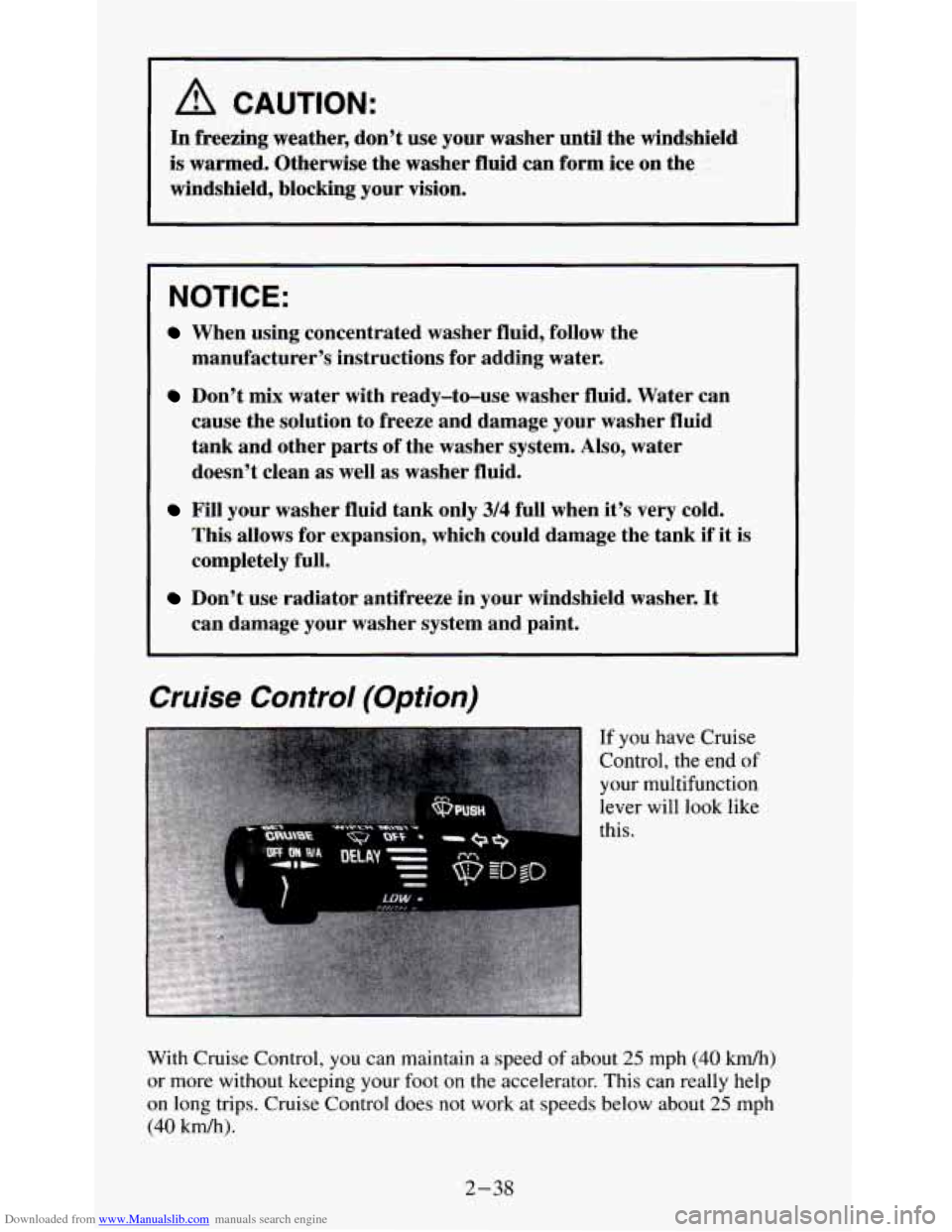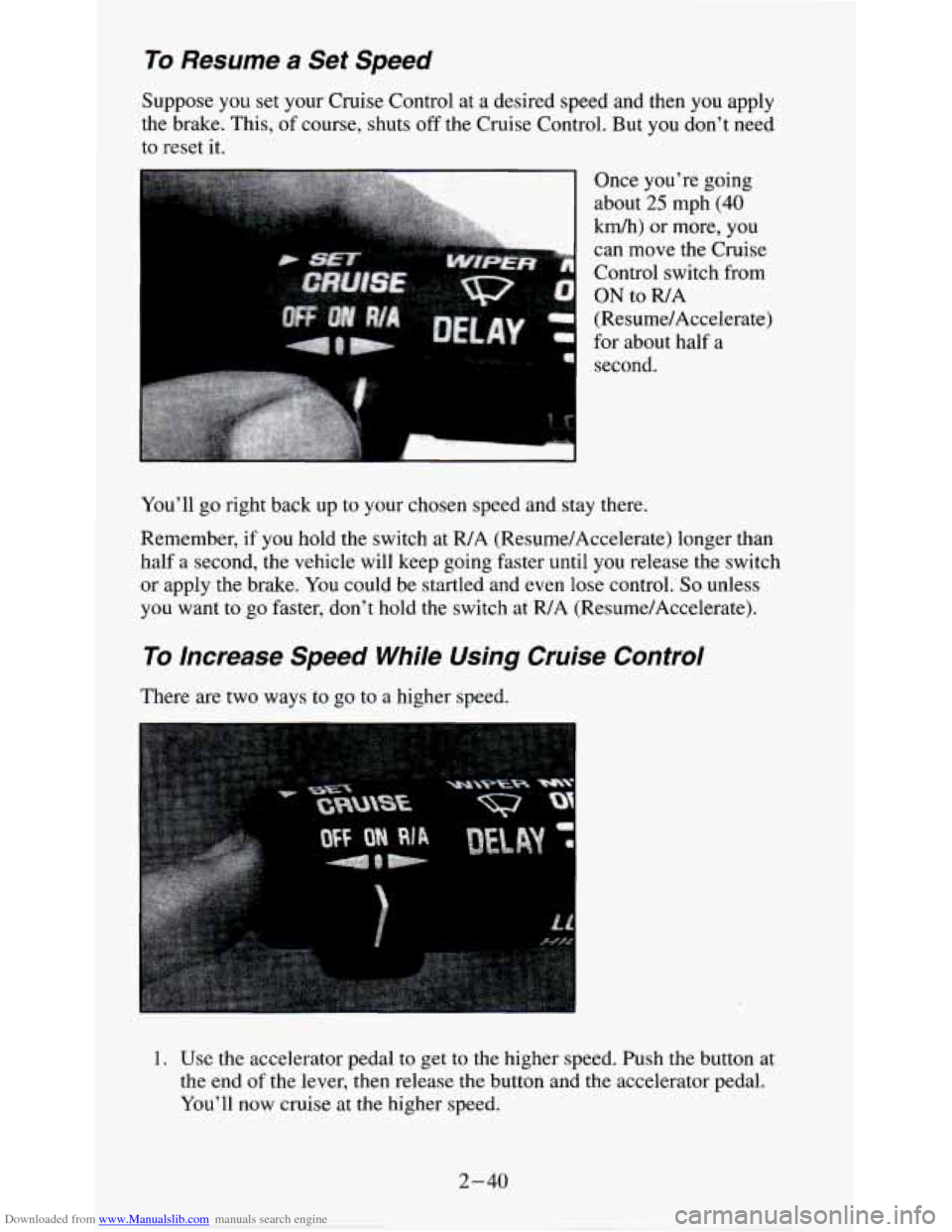Page 79 of 354
Downloaded from www.Manualslib.com manuals search engine Tilt Wheel (Option)
I
I
If you have the tilt
steering wheel,
you
should adjust the
steering wheel before
you drive.
You can raise it
to the highest level to give your legs more room when you
enter and exit the vehicle.
To tilt the wheel, hold the steering wheel and pull the lever. Move the
steering wheel to a comfortable level, then release the lever to lock the
wheel in place.
Do not adjust the steering wheel while driving.
Multifunction Lever
The lever on the left side of the steering column includes your:
Turn Signal and Lane Change Indicator
Headlamp High-Low Beam
0 Windshield Wipers
Windshield Washer
Cruise Control (Option)
2-34
Page 83 of 354

Downloaded from www.Manualslib.com manuals search engine A CAUTION: I
In freezing weather, don’t use your washer until the windshield
is warmed. Otherwise the washer fluid can form ice on the
windshield, blocking your vision.
I
NOTICE:
When using concentrated washer fluid, follow the
manufacturer’s instructions for adding water.
Don’t mix water with ready-to-use washer fluid. Water can
cause the solution to freeze and damage your washer fluid
tank and other parts of the washer system. Also, water
doesn’t clean
as well as washer fluid.
Fill your washer fluid tank only 3/4 full when it’s very cold.
~ This allows for expansion, which could damage the tank if it is
completely full.
Don’t use radiator antifreeze in your windshield washer. It
can damage your washer system and paint.
Cruise Control (Option)
If you have Cruise
Control, the end
of
your multifunction
lever will
look like
this.
With Cruise Control,
you can maintain a speed of about 25 mph (40 kdh)
or more without keeping your foot on the accelerator. This can really help
on long trips. Cruise Control does not work at speeds below about 25 mph
(40 km/h).
2-38
Page 84 of 354
Downloaded from www.Manualslib.com manuals search engine If you have an automatic transmission and you apply your brakes, the
Cruise Control will shut
off.
If you have a manual transmission and you apply your brakes or push the
clutch pedal, the
Cruise Control will shut off.
To Set Cruise Control
1. Move the Cruise
Control switch
to
ON.
A CAUTION:
If you leave your Cruise Control switch on when you're not
using Cruise, you
mi&€ hit a button and go into Cruise when
you don't want to- Yaw could be startled and even lose control.
Keep the Cruise Control switch OFF until you want to use it.
2. Get up to the speed you want.
3. Push in the set button at the end of the lever and release it.
4. Take your foot off the accelerator pedal.
2-39
Page 85 of 354

Downloaded from www.Manualslib.com manuals search engine To Resume a Set Speed
Suppose you set your Cruise Control at a desired speed and then you apply
the brake. This,
of course, shuts off the Cruise Control. But you don’t need
to reset
it.
Once you’re going
about
25 mph (40
km/h) or more, you
can
move the Cruise
Control switch from
ON to R/A
(Resume/Accelerate)
for about half a
second.
You’ll go right back up to your chosen speed and stay there.
Remember,
if you hold the switch at R/A (Resume/Accelerate) longer than
half
a second, the vehicle will keep going faster until you release the switch
or apply the brake. You could be startled and even lose control. So unless
you want to
go faster, don’t hold the switch at R/A (Resume/Accelerate).
To Increase Speed While Using Cruise Control
There are two ways to go to a higher speed.
1. Use the accelerator pedal to get to the higher speed. Push the button at
the end
of the lever, then release the button and the accelerator pedal.
You’ll now cruise at the higher speed.
2-40
Page 86 of 354
Downloaded from www.Manualslib.com manuals search engine I
2. lvlove the Cruise
switch from
ON
to WA
(Resume/Acceler
ate). Hold
it there
until you get up
to the speed you
want, and then
release the
switch.
To increase your speed in very small amounts, move the switch to WA
(Resume/Accelerate). Each time you do this, your vehicle will go about
1
mph (1.6 km/h) faster.
To Reduce Speed While Using Cruise Control
Push in the button at
the end
of the lever
until you reach the
lower speed you want,
then release
it.
To slow down in very small amounts, push the button for less than half a
second. Each time
you do this, you’ll go 1 mph (1.6 kmh) slower.
Passing Another Vehicle While Using Cruise Control
Use the accelerator pedal to increase your speed. When you take your foot
off the pedal, your vehicle will slow down to the Cruise Control speed you
set earlier.
2-41
Page 87 of 354
Downloaded from www.Manualslib.com manuals search engine Using Cruise Control on Hills
How well your Cruise Control will work on hills depends upon your speed,
load, and the steepness of the hills. When going up steep hills, you may
want to step on the accelerator pedal to maintain your speed. When going
downhill, you may have to brake
or shift to a lower gear to keep your speed
down. Of course, applying the brake takes you
out of Cruise Control. Many
drivers find this to be too much trouble and don’t
use Cruise Control on
steep hills.
To Get Out of Cruise Control
There are two ways to turn off the Cruise Control:
To Erase Speed Memory
0 Step lightly on
the brake pedal or
push the clutch
pedal,
if you have
a manual
transmission.
0 Move the Cruise
switch to
OFF.
When you turn off the Cruise Control or the ignition, your Cruise Control
set speed memory is erased.
2-42
Page 286 of 354
Downloaded from www.Manualslib.com manuals search engine NAME
WIPER
BRAKE
4WD CRANK
FOG
AIR BAG
TRANS
PRNDL
CIRCUITS PROTECTED
Windshield Washer, Windshield Wiper Motor
DRAC, Anti-Lock Braking System, Cruise Control
Electric Shift Transfer Case
Crank Signal
Fog Lamp Relay, Fog Lamps
Air Bag Module
4L60E Automatic Transmission
PRNDL Power
Service Replacement Part and Filter
Recommendations
Engine (VIN)
Oil Filter
Air Cleaner
Filter
PCV Valve
Spark Plugs*
Fuel Filter
Radiator Cap
2.2L (4)
PF47 A1163C
cv9ooc
2457 49 12
GF48
1
RC27
4.3L (Z)
PF52
A773C
CV789C .CR43TSM
GF48
1
RC27
4.3L (W)
PF52
A1163C
cv774c .CR43TSM
GF48
1
RC27
*Use copper-cored resistor type spark
plugs.
6-69
Page 326 of 354

Downloaded from www.Manualslib.com manuals search engine Steering and Suspension Inspection
Inspect the front and rear suspension and steering system for damaged,
loose or missing parts, signs of wear, or lack of lubrication. Inspect power
steering
lines and hoses for proper hookup, binding, leaks, cracks,
chafing, etc.
Exhaust System Inspection
Inspect the complete exhaust system. Inspect the body near the exhaust
system. Look for broken, damaged, missing or out-of-position parts as well
as open seams, holes, loose connections, or other conditions which could
cause a heat build-up in the floor pan or could let exhaust fumes into the
vehicle. See “Engine Exhaust” in the Index.
Accelerator Control System
Lubricate all pivot points with engine oil, except the TBI throttle shaft. Do
not lubricate the cam pulley. Remove all external deposits from pulley. Do
not oil any accelerator or cruise control cables. Replace any cables that have
high effort or excessive wear.
Drive Axle Service
Check readfront axle fluid level and add as needed. Check constant velocity
joints and axle seals for leaking.
Transfer Case (Four- Wheel Drive) Inspection
Every 12 months or at oil change intervals, check front axle and transfer
case and add lubricant when necessary. Oil the control lever pivot point and
all exposed control linkage. Check vent hose
at transfer case for kinks and
proper installation. More frequent lubrication may be required on off-road
use.
7-39